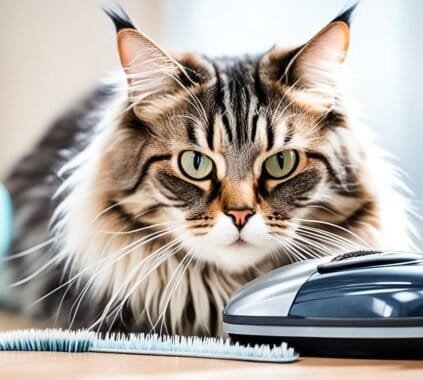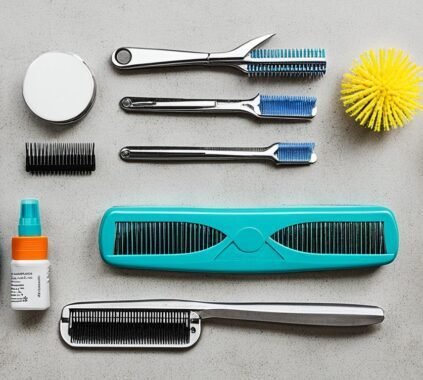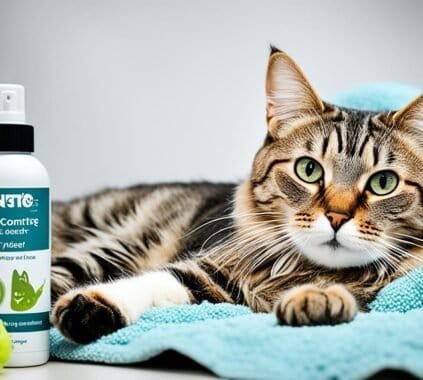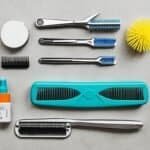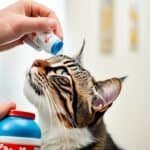Cats are known for their meticulous grooming habits, but sometimes this grooming can lead to a common issue – hairballs. Hairballs occur when cats swallow fur during the grooming process, and the fur accumulates in their stomach. While occasional hairballs are normal, frequent hairballs can indicate an underlying health issue and may cause discomfort for your feline friend.
In this section, we will explore effective tips for cat hairball prevention in cats. By implementing these strategies, you can help keep your cat’s digestive system healthy and minimize the formation of hairballs.
Key Takeaways:
- Regular brushing helps remove loose fur and reduce the amount of fur ingested by cats.
- Providing a balanced diet that includes high-quality cat food and fiber can promote healthy digestion and reduce the formation of hairballs.
- Consider using hairball remedies such as over-the-counter medications or vet-approved supplements to aid in the prevention of hairballs.
- Promote hydration by ensuring your cat has access to fresh water at all times, as dehydration can contribute to hairball formation.
- Consult with your veterinarian for a personalized hairball prevention plan tailored to your cat’s specific needs and potential underlying health issues.
Understanding Hairballs in Cats
Hairballs in cats are a common issue that many cat owners have encountered. These hairballs typically appear as wads of fur that have a tubular shape. So, what does a cat hairball look like? Well, imagine a tightly packed mass of fur that has been coughed up or vomited by your feline friend.
But why do cats get hairballs in the first place? Cats naturally swallow fur while grooming themselves. However, sometimes the fur accumulates in their stomach instead of passing through the digestive system. This accumulation leads to the formation of hairballs. Since fur is not digestible, when large clumps of fur gather together, it can create a hairball that cats need to expel.
Excess fur ingestion is one of the primary reasons why cats get hairballs. Cats have barbs on their tongue that catch loose fur while they groom, and this fur eventually makes its way to their stomach. Additionally, certain factors, such as gastrointestinal issues, can contribute to the development of hairballs in cats. If a cat’s digestive system is not functioning optimally, hair may get trapped in the stomach, leading to hairball formation.
To further understand the appearance of a cat hairball, visualize a cylinder-shaped mass composed of tightly packed fur. The hairball can vary in size, depending on how much fur the cat has ingested. Cats with longer hair are more prone to hairballs, as they tend to have more loose fur that gets caught during grooming.
It’s important to note that occasional hairballs are considered normal for cats. However, frequent hairballs could indicate an underlying health issue that requires attention. If you notice your cat is experiencing frequent hairballs or if they are accompanied by other concerning symptoms, it’s best to consult a veterinarian for a proper diagnosis and treatment plan.
Signs and Symptoms of Hairballs in Cats
Cats often exhibit signs of retching, gagging, and coughing when trying to expel a hairball. These actions are their attempts to rid themselves of the hairball discomfort. If you notice your cat frequently coughing up hairballs, it may be a sign of excessive fur ingestion. The hairball may eventually be vomited, providing relief to the cat. However, if a hairball becomes stuck in the digestive tract, it can lead to more serious symptoms such as:
- Lack of appetite
- Lethargy
- Constipation
- Diarrhea
These symptoms indicate that the hairball is causing an obstruction or irritation in the cat’s digestive system. If your cat experiences these symptoms, it is important to seek veterinary care for proper diagnosis and treatment. A veterinarian will be able to assess the severity of the situation and recommend the appropriate course of action to alleviate any discomfort or potential health risks.
It is essential to monitor your cat’s behavior and look out for these signs of hairball-related issues. Prompt veterinary attention can help prevent complications and ensure your cat’s well-being.
Remember, preventing hairballs is crucial for the overall health and happiness of your feline companion. By understanding the signs and symptoms of hairballs, you can take proactive steps to minimize their occurrence and keep your cat comfortable.
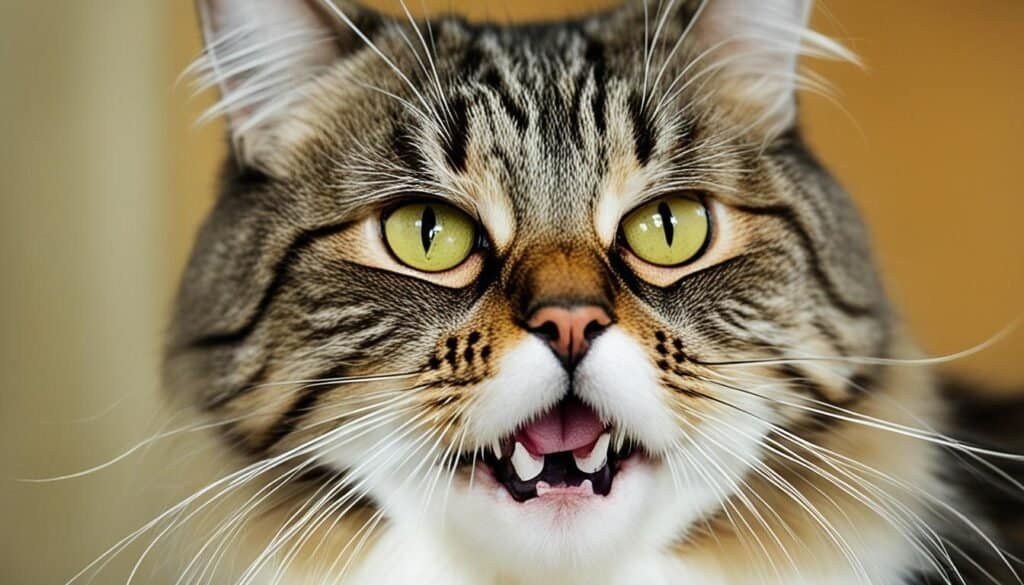
Treating Hairballs in Cats
In cases where cats only occasionally develop hairballs, home treatment options such as over-the-counter hairball medicine or natural remedies can be effective. However, if hairballs occur frequently or are accompanied by other symptoms, it is crucial to consult a veterinarian.
Veterinarians are skilled in diagnosing the underlying cause of hairballs and providing appropriate treatment. They may recommend dietary changes, prescription medications, or surgical intervention in severe cases to address the root cause of hairball formation and provide long-term relief for your feline companion.
By consulting with a veterinarian, you can ensure that your cat receives the most accurate diagnosis and tailored treatment plan. This will help address the specific needs and health conditions of your cat, leading to effective management and prevention of hairballs.
Home Remedies for Cat Hairball Prevention
While it is important to address any underlying health issues causing frequent hairballs, there are also safe home remedies that can help reduce hairball occurrence. These remedies include:
- Over-the-counter hairball medicine: These products are specifically formulated to aid in the prevention and elimination of hairballs. They often contain ingredients that help lubricate the digestive tract, making it easier for hairballs to pass through.
- Vet-approved natural supplements: Some natural supplements, such as petroleum-free hairball gels or oils, can help prevent hairball formation by promoting healthy digestion and reducing the likelihood of hairball blockages.
- Hairball treats: These specialized treats are designed to help prevent hairball formation. They usually contain ingredients that aid in hairball digestion and encourage healthy bowel movements.
- Hairball control food for cats: Certain cat foods are formulated with added fiber or other ingredients that help reduce hairball formation and promote healthy digestion. These foods can be an effective long-term solution for cats prone to hairballs.
Remember to always follow the recommended dosage and consult with a veterinarian before using any home remedies. Each cat is unique, and a veterinarian can provide tailored advice based on your cat’s specific needs and health condition.

Implementing these home remedies can help minimize the occurrence of hairballs and promote a healthier digestive system in your cat. However, it is important to remember that if your cat continues to experience frequent hairballs or displays other concerning symptoms, it is crucial to seek professional veterinary care for proper diagnosis and treatment.
Preventing Cat Hairballs
Regular brushing is essential for preventing hairballs in cats, especially for long-haired breeds. Brushing helps remove loose hair and prevents excessive fur ingestion, reducing the likelihood of hairball formation. Make sure to use a brush that is suitable for your cat’s fur type, such as a slicker brush or a comb with wide teeth.
When brushing your cat, start from the head and work your way down to the tail, following the direction of hair growth. Pay extra attention to areas prone to matting, such as the belly and behind the ears. Be gentle and patient, ensuring a positive experience for your cat. Regular brushing not only prevents hairballs but also promotes a healthy coat and strengthens the bond between you and your furry friend.
In addition to brushing, there are other grooming tips that can help prevent hairballs in cats. Keeping your cat well-groomed includes regular nail trims and keeping their ears clean. Regular visits to a professional groomer can be beneficial, especially for cats with thick or difficult-to-maintain coats.
Other Tips for Hairball Prevention:
- Provide your cat with a balanced diet that includes high-quality cat food formulated to promote hairball control. Look for cat foods that contain adequate fiber to aid in digestion and the elimination of hairballs.
- Consider adding a hairball prevention supplement to your cat’s diet, as recommended by your veterinarian. These supplements often contain ingredients such as psyllium husk or malt extract, which help with the passage of hair through the digestive system.
- Offer your cat a dedicated hairball control treat, which can further assist in reducing the formation of hairballs. These treats often have added fiber and enzymes to aid in digestion.
- Ensure your cat stays hydrated by regularly providing fresh water. This helps maintain healthy gastrointestinal function and prevents excessive dryness of the stools, which can contribute to hairball formation.
A proactive approach to preventing hairballs is crucial for the well-being of your cat. By incorporating regular brushing, proper grooming techniques, and implementing dietary measures, you can significantly reduce the occurrence of hairballs and promote a healthier digestive system for your feline companion.
Conclusion
Hairball prevention is crucial for the overall health and well-being of cats. By understanding the causes of hairballs, recognizing their signs and symptoms, and implementing preventive measures, cat owners can ensure that their feline companions live a hairball-free life. Regular grooming, providing an appropriate diet, and seeking veterinary care are key components in preventing hairballs and promoting the overall health of cats.
When it comes to preventing hairballs, choosing the right cat food is essential. Look for specially formulated cat foods that are designed to control hairballs. These foods often contain added fiber to help move ingested fur through the digestive system, reducing the likelihood of hairball formation. Consult with your veterinarian to determine the best cat food for hairball control that suits your cat’s specific needs and dietary requirements.
In addition to a proper diet, regular grooming plays a significant role in preventing hairballs. Brushing your cat’s coat on a consistent basis helps remove loose hair and prevents excessive fur ingestion during self-grooming. Long-haired cats may require daily brushing, while short-haired breeds can benefit from a weekly grooming routine. Remember to use cat-friendly grooming tools and make the grooming experience enjoyable for your furry friend.
To further enhance hairball prevention, it is vital to provide your cat with appropriate dental care, as oral hygiene can impact overall health. Regular veterinary check-ups are crucial for early detection and management of any potential underlying health issues that may contribute to hairball formation. Together with a balanced diet, regular grooming, and proactive veterinary care, you can help your cat lead a healthy and hairball-free life.
FAQ
How can I prevent hairballs in my cat?
What are the signs and symptoms of hairballs in cats?
How are hairballs in cats treated?
Are there any home remedies for preventing hairballs in cats?
How important is regular brushing for preventing hairballs in cats?
Last modified: February 25, 2024



